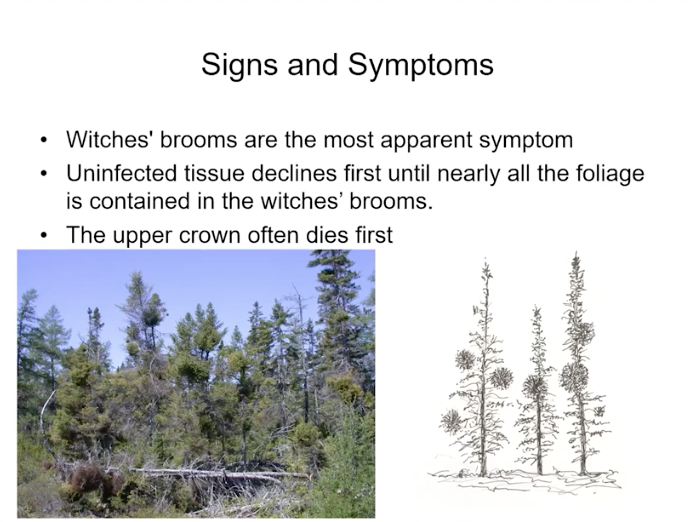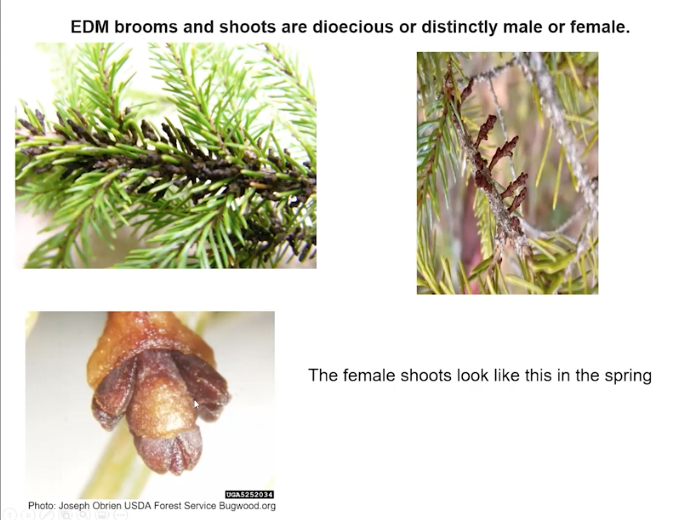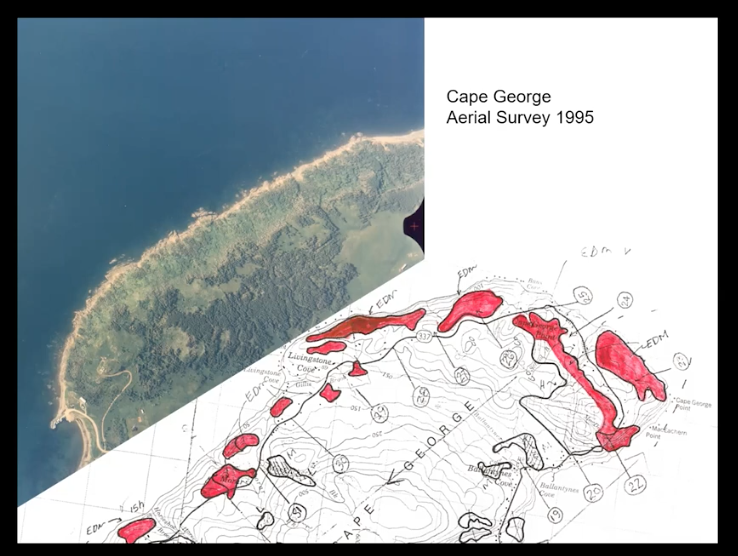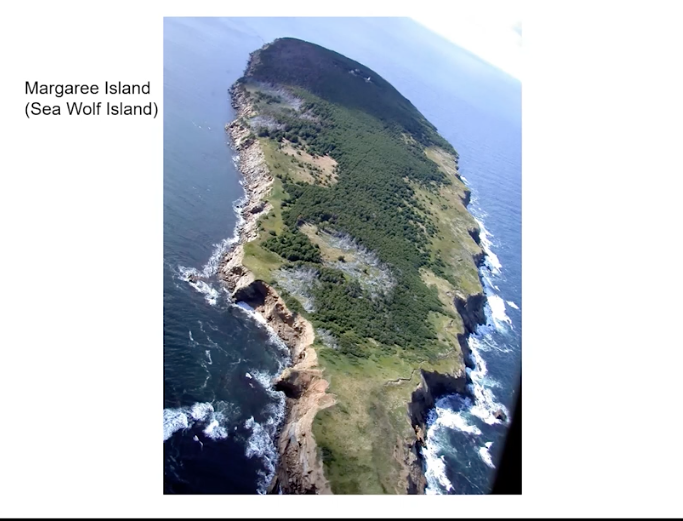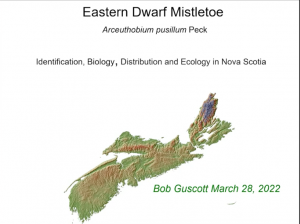 Retired DNR pest and GIS specialist Bob Guscott has had an “obsession” with Eastern Dwarf Mistletoe for many years.
Retired DNR pest and GIS specialist Bob Guscott has had an “obsession” with Eastern Dwarf Mistletoe for many years.
He recently shared his wealth of knowledge about this early flowering Nova Scotia plant in a presentation to the Nova Scotia Wild Flora Society, available now as a YouTube Video.
‘Guaranteed that once you have viewed it, your eyes will look at NS forests differently, particularly close to the coast. Hint: Bob has even used Google Maps ground views to document occurrence of Eastern Dwarf Mistletoe in NS.
It’s a wonderful story of scientific curiosity and natural history by a critical observer over a lifetime and ongoing.
Thx, Bob G. for sharing it with all of us
———
More Hints on why you will look at NS forests differently, from the ground and from the air. From Bob’s slides:
From Discussion on Annapolis Royal & Area – Environment & Ecology
DO: Remarkable, what we don’t know, eh? It’s very interesting; I have a lot of dwarf mistletoe in my woodlands, and a lot of mortality that I was ascribing beetles and overstocked, even-aged stands. I’ve been assuming that it hits fir as much or more than spruce in our woods; I must check that.
BW to DO: I’m sure that Bob Guscott would be very interested in hearing from you. He seemed quite keen to receive observations. He too ascribed the mortality to beetles, but based on much observation, has come to the realization that Dwarf Mistletoe is the culprit. Did you watch the talk yet? It’s interesting how those circular patches of dead spruce happen and that it’s a very visible indicator when seen from above. Anyhow, I’ll be watching for it and photographing it any time I see it from now on. I noticed in his presentation that he has not got all that much in the way of records from around my area, but I think that has more to do with him not having time to get to some areas but has been able to survey others. I did notice that the North Mountain has a lot of it. Interesting as a friend over there has been telling me that the trees on her land seem to be dying and she wondered if there was some disease killing them. Now I’ll have to take a look at which trees they are and if they have Mistletoe.
DGP to DO: It doesn’t infect fir, that would be fungal. Bob provides good clues to the agent.
KOB: I also thought the mortality of the spruce was from the Spruce beetle. Will be going out today checking for the Dwarf Mistletoe. The spruce trees around my house are covered in brooms.
Thank you for sharing this very informative video.
BW to DGP: Excellent. I emailed a friend at Karsdale this morning as her trees have been dying from something and she described the “war club” things on them. She has told me that some of the neighbours are losing their forests as well. Bob’s map showed infestations from about Karsdale out to Victoria Beach.
DO: Enlightened now – I have assumed that all the witches broom that I see on my fir trees was EDM, when none of it is. And I have a LOT of witches broom on our woodlot. Will go look more closely at my ailing spruces now…
& these Q&A exchanges between BW and Bob Guscott:
BW: Bob mentioned that it seems to have more of an impact on trees during dry years (kills the tree). Is climate change a factor in the growing abundance of Mistletoe infected trees?
BG: I have no doubt that climate change will have an impact on the health of mistletoe infected spruce. When a spruce tree is heavily impacted by mistletoe, most of the nutrients and water get redirected to the mistletoe brooms to the detriment of normal tissues and branch growth. (often the needles are smaller and discoloured with the unaffected crowns dying off first) These mistletoe affected spruce trees have very poor vigor and always seem to be on the brink of death. As we continue to set new records for heat and drought in parts of NS I would expect to see an increase in spruce mortality due to mistletoe parasitism.
BW: Bob also mentioned that infected trees will burn easily — that the witch’s brooms caused by the Mistletoe are highly flammable. Is this a factor in what seems to be a growing number of wildland fires in Nova Scotia?
BG: I think mistletoe infection could be a strong contibuting factor, especially in our southern coastal black spruce forests. There is very strong evidence from western US and Canada with different dwarf mistletoes and different conifers that cite increases in wildfire risk from mistletoe infection.
” The large, pendulous brooms usually occur in the lower portion of the crown and are filled with small twigs and dead needles that provide a fuel ladder for upward spread into tree crowns. Brooms broken off by winter storms accumulate around the base of infected trees and increase the fuels on site. It has also been reported by firefighters that large witches’ brooms can fall off burning trees on steep hillsides and quickly spread fire downhill via “flaming pinwheels.”
https://www.fs.usda.gov/Internet/FSE_DOCUMENTS/stelprdb5187427.pdf
BW: I was also curious about which birds might spread the seed. In Arizona where I have spent a number of winters, there is a bird (Pyrrhuloxia) that spreads the Mistletoe that infests Mesquite trees. The birds eat the Mistletoe berries and spread them further afield.
BG: I do not know if the eastern dwarf mistletoe seeds are viable after ingestion by animals. But there is clear evidence that animals can transport viable seeds long distances. An animal Vector study from Minnesota showed that flying squirrels and gray jays were frequently captured with viable seeds in their fur or feathers. They also collected seeds from warblers and juncos.
Many coastal islands in Nova Scotia have mistletoe outbreaks in black or white spruce stands. I would love to know which species of birds are flying out to these islands in the fall and carrying mistletoe seeds.
https://www.nrs.fs.fed.us/pubs/753
BW: Bob mentioned that he had just looked at observation records for Mistletoe in Nova Scotia using iNaturalist and seemed quite excited about that. David, do you think we should be encouraging people to watch for witch’s broom and post the observations into iNaturalist so that Bob can use them in his database?
BG: Inaturalist is a game changer for citizen science. I think that it has tremendous potential to help map mistletoe distribution. Once a spruce stand is infected it will stay infected for many decades or longer unless it is burned, clearcut or cleared and developed. I have been using the Google Earth platform to map mistletoe distribution in NS. It is exciting to think that others will be posting other mistletoe locations across the province on Inaturalist.
BW: Anyhow, this seems like important information — something that we should all be more aware of as it is obviously having aa rather large impact on Nova Scotia forests.

